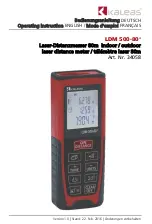
Sensors
Natural Wet Bulb Thermometer
5
Sensors
Natural Wet Bulb Thermometer
The natural wet bulb thermometer gives an indication of the effects of humidity on an individual.
Relative humidity and wind speed are taken into account by measuring the amount of
evaporative cooling taking place at a thermometer covered with a moistened wick.
Check Wick and Fill Natural Wet Bulb
The QUESTemp uses a cotton wick immersed into a reservoir containing distilled water.
Ordinary tap water should not be used, as the contaminants that are left behind after
evaporation will shorten the life of the wick and cause high readings. If the wick is
discolored it should be replaced. To
replace the wick
, slide the old wick off the top of the
sensor. Place a new wick over the sensor, making sure that the bottom of the wick is down
in the reservoir.
Figure 1-4: Filling wet bulb reservoir
Globe Thermometer
The globe thermometer (left position) gives an indication of the radiant heat exposure on an
individual due to either direct sunlight or hot objects in the environment. This is
accomplished by placing a temperature sensor inside a blackened copper sphere and
measuring the temperature rise. The WBGT index is based on the response of a 6 inch
diameter globe. The QUESTemp uses a 2 inch diameter globe for a faster response time.
The temperature of the 2 inch globe is correlated to match that of a 6 inch globe.
Dry Bulb Thermometer
The dry bulb thermometer (right position) measures the ambient air temperature. This
measurement is used in the outdoor WBGT calculation when a high solar radiant heat load
may be present. The series of white plates surrounding the sensor shield it from radiant
heat.
Relative Humidity Sensor
A relative humidity sensor is located in a compartment inside of the sensor bar housing.
Slots in the housing allow air to circulate around the sensor.
Wick
Reservoir cover
Reservoir
Filling wet bulb reservoir
1. Remove reservoir cover and fill with distilled or
de-ionized water.
2. Replace reservoir cover.
A. Globe thermometer
B. Natural wet bulb thermometer
C. Dry bulb thermometer
A
B
C
Sensors










































